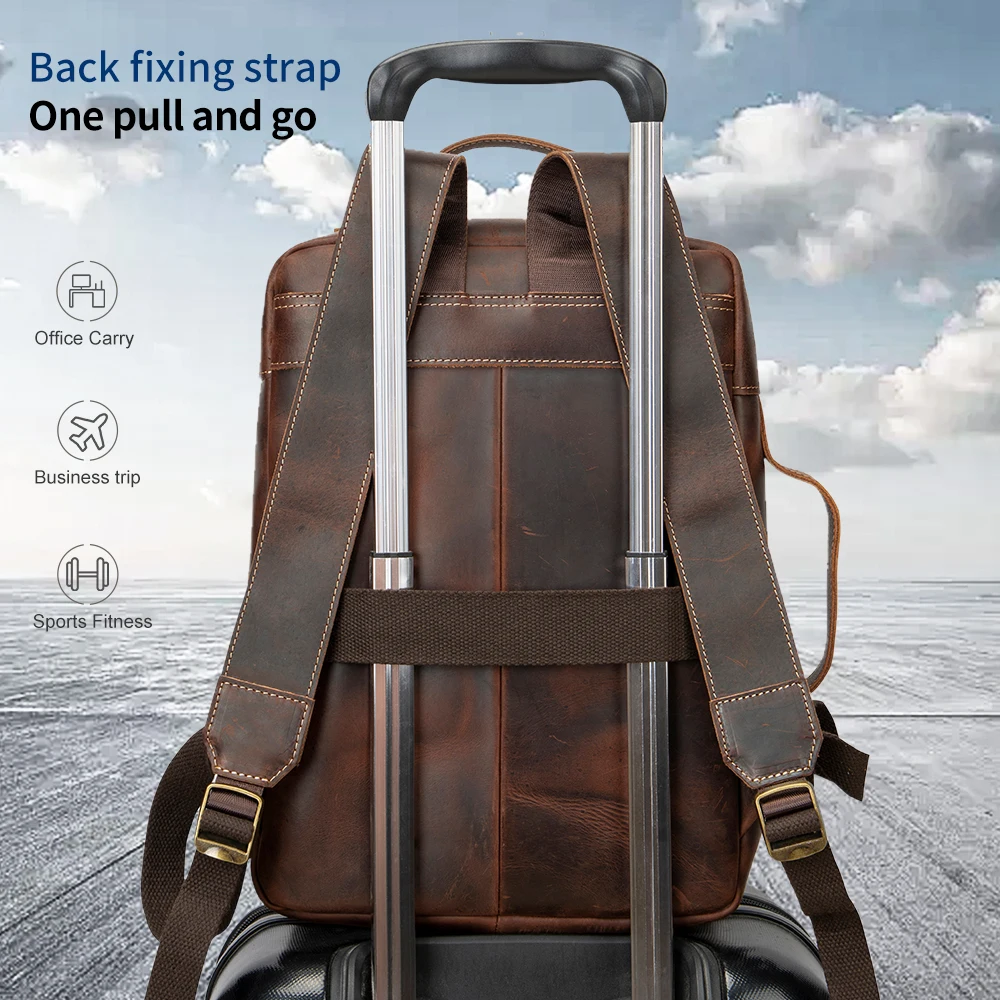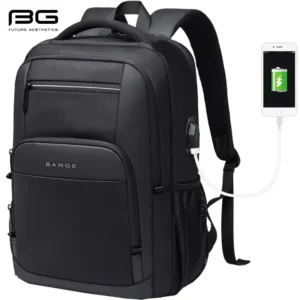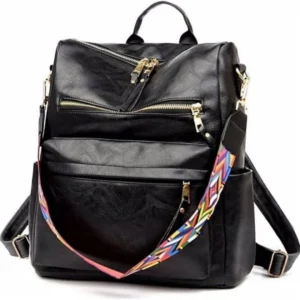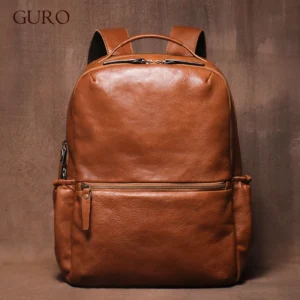Introduction: The Modern Man’s Essential Companion
Today’s modern man lives a life of constant transition – from morning meetings to evening social events, from weekday office hours to weekend getaways. This lifestyle demands accessories that can keep pace, which is why multi-use leather backpacks have become an essential companion for men who value both style and function.
What makes a leather backpack truly “multi-use”? It’s the thoughtful design that allows it to transition seamlessly between professional environments, casual settings, and travel scenarios. These bags offer versatility without compromising on appearance or functionality, making them ideal for men who need their accessories to work as hard as they do.
Leather stands as the premium material of choice for these versatile carriers, offering unmatched durability, a professional appearance, and a timeless appeal that improves with age. Unlike synthetic alternatives, quality leather develops character over time, telling the story of your journeys together.
Men’s bags have evolved dramatically from purely utilitarian items to becoming significant style statements that reflect personality and status. As workplace norms continue to evolve and hybrid lifestyles become more common, the need for versatile leather bags for men that can adapt to changing circumstances has never been greater.
This comprehensive guide will help you navigate the world of multi-use leather bags specifically designed for men, examining everything from essential features to maintenance tips, ensuring you find the perfect leather companion for your lifestyle.
Why Choose a Multi-Use Leather Backpack?
Versatility Across Environments
The primary advantage of a multi-use leather backpack lies in its adaptability. These thoughtfully designed bags seamlessly transition from corporate boardrooms to weekend coffee shops without missing a beat. Many feature convertible carrying systems that transform from backpack to briefcase or messenger bag depending on the situation, giving you multiple bags in one sleek package.
Imagine starting your day with a comfortable backpack for your bicycle commute, converting to a professional briefcase for client meetings, then switching back to a backpack for your evening gym session – all with the same bag. This versatility eliminates the need to transfer essentials between multiple bags and ensures you always have the appropriate accessory for any environment.
Long-Term Investment Value
Quality leather backpacks represent an initial investment, but their cost-per-use value significantly outperforms cheaper alternatives. While a synthetic backpack might need replacement every 1-2 years with regular use, a well-crafted leather backpack can serve faithfully for decades when properly maintained.
What makes leather particularly special is its unique aging process. Unlike synthetic materials that simply wear out, quality leather develops a rich patina over time that enhances its appearance and tells your unique story. This natural evolution creates a personalized accessory that becomes more distinctively yours with each passing year.
The durability factor cannot be overstated – quality leather withstands abrasion, resists tears, and holds its structural integrity through years of daily use. In an era of disposable products, a leather backpack stands as a refreshing counterpoint to throwaway culture.
Professional Aesthetic
There’s something unmistakably elevated about leather accessories in professional settings. A quality leather backpack communicates attention to detail and appreciation for craftsmanship without saying a word. This subtle message can create positive impressions in business environments where appearance matters.
The psychological impact of carrying quality accessories extends beyond external perceptions. Many men report feeling more confident and prepared when equipped with tools that reflect their professional standards. The right leather backpack doesn’t just carry your belongings – it reinforces your personal brand.
Organizational Efficiency
Rather than maintaining separate bags for different purposes, a well-designed multi-use backpack provides thoughtful organization for all your needs. The functionality of men’s leather bags has evolved dramatically to accommodate modern essentials.
Today’s best designs feature padded laptop compartments, tablet sleeves, document organizers, and clever storage for daily necessities like keys, phones, and wallets. This intelligent organization reduces daily stress by ensuring everything has its place and remains accessible when needed.
The psychological benefit of this organization extends beyond convenience – it creates efficiency in daily routines and eliminates the frustrating search for misplaced items. When designed properly, these organizational systems promote productivity by keeping essential tools at your fingertips.
For men seeking maximum versatility with minimum compromise, convertible leather backpacks provide the perfect balance of function, style, and adaptability across various life scenarios.
Essential Features: What Makes a Leather Backpack Truly Multi-Use
Premium Leather Quality
The foundation of any exceptional leather backpack begins with the material itself. Understanding leather quality helps you make an informed investment:
Full-grain leather represents the highest quality available, incorporating the entire top layer of the hide with all its natural grain and character. This unaltered surface develops a beautiful patina over time while offering superior durability and moisture resistance. Though it commands premium prices, full-grain leather provides unmatched longevity and character.
Top-grain leather undergoes light sanding to remove imperfections, resulting in a more uniform appearance. While slightly less durable than full-grain, it remains an excellent choice for quality backpacks, offering a good balance between appearance, performance, and price.
Genuine leather is a lower grade created from the hide layers remaining after top-grain is removed. Despite the misleading name, it’s actually the third tier of leather quality, offering less durability and character development.
Quality leather can be identified through several indicators:
– Rich, natural smell (not chemical or artificial)
– Visible pores and slight imperfections in the surface
– Edges that are properly finished and sealed
– Supple feel that’s neither too rigid nor too soft
– Natural variations in color and texture
Versatile Design Elements
The most effective multi-use backpacks incorporate design elements that enable adaptation to different scenarios:
Convertible strap systems allow the same bag to be carried as a backpack, shoulder bag, or briefcase. Look for designs with hideaway straps, multiple attachment points, and easy adjustment mechanisms that facilitate quick transitions.
Modular components such as removable organizers, detachable pouches, or expandable sections provide customization for different carrying needs. These elements allow the bag to grow or shrink depending on your daily requirements.
Aesthetic balance is crucial for true versatility. The most adaptable designs incorporate subtle styling that works appropriately across formal business settings, casual environments, and travel scenarios. Look for clean lines, minimal branding, and classic proportions that won’t appear out of place in varied contexts.
Intelligent Organization
The internal architecture of a multi-use backpack determines its functional versatility:
Technology protection has become essential, with dedicated compartments for laptops (typically accommodating 15-16 inch devices), tablets, and other electronics. These sections should feature adequate padding and secure closures to prevent movement and potential damage.
Document management remains important even in our digital world. Look for flat storage areas that prevent paper wrinkles, portfolio sections for important materials, and quick-access slots for frequently needed items like boarding passes or identification.
Adaptable main compartment designs allow for various packing approaches. The best options feature compartments that can be reconfigured based on your needs, whether carrying clothes for an overnight trip or equipment for a day at the office.
Quick-access storage for essentials enhances daily usability. Strategic exterior pockets for phones, transit cards, and keys prevent the frustration of digging through your main compartment for frequently needed items.
Comfort Features
Even the most beautiful backpack fails if it’s uncomfortable during extended use:
Ergonomic back panels with proper contours and padding distribute weight evenly across your back. Some premium designs incorporate ventilation channels to reduce heat buildup during warmer weather or longer carrying periods.
Properly padded shoulder straps prevent digging and discomfort. The best designs feature width appropriate to the bag’s intended capacity and padding density matched to typical carrying loads.
Weight distribution engineering becomes increasingly important as capacity increases. Look for designs that keep the load close to your body’s center of gravity and prevent items from shifting during movement.
With their emphasis on premium materials and thoughtful design, full-grain leather backpacks deliver the perfect foundation for a truly multi-functional carrying solution.
Size and Capacity: Finding Your Perfect Fit
Selecting the appropriate size for your leather backpack might be the most critical decision affecting its multi-use functionality. Too large, and you’ll carry unnecessary bulk during daily use; too small, and you’ll find yourself constrained during travel or busier days.
Understanding capacity measurements helps make informed comparisons. While backpack dimensions (height × width × depth) give you an idea of external size, capacity (measured in liters or cubic inches) more accurately reflects actual carrying ability. Here’s a practical breakdown of capacity categories:
| Size Category | Capacity | Ideal Uses | Typical Dimensions | Weight Range |
|---|---|---|---|---|
| Compact | 14-18 liters (853-1098 cu in) | Daily commuting, essentials only | 16-18” × 11-13” × 4-5” | 2.0-3.0 lbs (0.9-1.4 kg) |
| Medium | 19-25 liters (1159-1525 cu in) | Work with overnight capacity | 18-20” × 12-14” × 5-7” | 2.5-3.5 lbs (1.1-1.6 kg) |
| Large | 26-30 liters (1586-1830 cu in) | Extended travel capability | 20-22” × 13-15” × 7-9” | 3.0-4.5 lbs (1.4-2.0 kg) |
For frequent travelers, airline compatibility becomes an important consideration. Most standard carry-on restrictions limit bags to approximately 22 × 14 × 9 inches (56 × 36 × 23 cm), though requirements vary by airline and route. Medium-sized backpacks typically meet these requirements while offering sufficient capacity for most short trips.
When balancing capacity against comfort, remember that leather backpacks tend to weigh more than synthetic alternatives even when empty. A larger capacity bag made from full-grain leather might start at 3-4 pounds empty, meaning you’ll need to consider the total weight once packed. This makes efficient organization particularly important for leather bag owners.
Your selection should ultimately be guided by your most frequent use case rather than occasional scenarios. If you primarily need a daily commuting bag with occasional overnight capability, a medium-sized backpack (19-25 liters) typically provides the best balance. Those requiring regular travel capacity might prefer the upper end of the medium range or a large backpack, particularly if it features compression capabilities for daily use.
The unique requirements of business environments make executive leather backpacks for work particularly valuable for professionals who need capacity without sacrificing appropriate appearance.
Top Multi-Use Leather Backpacks for Different Needs
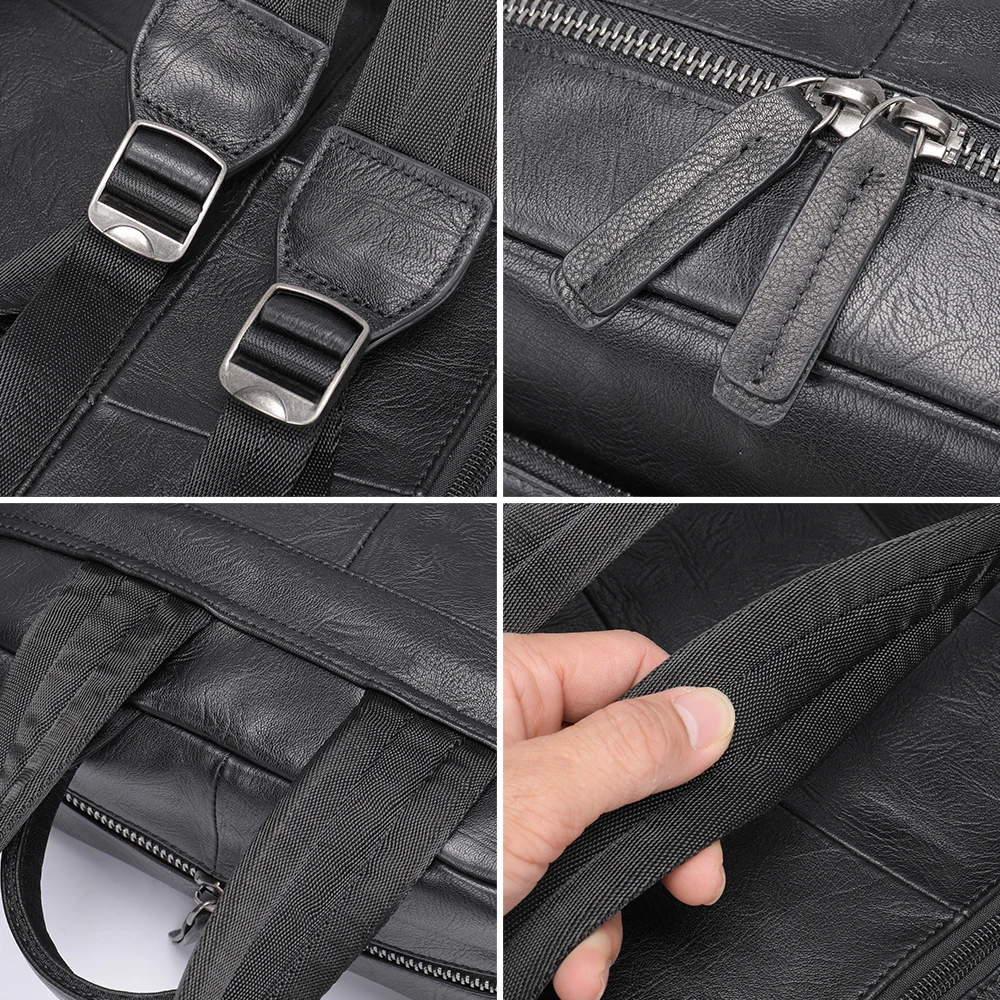
The Executive Commuter
The ideal executive commuter backpack balances professional appearance with practical organization for daily office use. These designs prioritize laptop protection and document management while maintaining a sleek profile appropriate for business settings.
Key features to look for include:
– Padded laptop compartment fitting devices up to 15-16 inches
– Dedicated tablet sleeve with soft lining
– Document organizer with multiple slots for papers, folders, and notebooks
– Streamlined external appearance with minimal hardware
– High-quality leather with subtle grain and professional finish
– Trolley sleeve for attaching to rolling luggage
The executive style typically features cleaner lines, more structured construction, and darker leather colors (black, dark brown, navy) that complement business attire. Weight distribution focuses on maintaining a slim profile against the back, preventing the bag from appearing bulky even when fully packed.
The Frequent Traveler
Travel-oriented leather backpacks emphasize versatility across different environments while meeting the practical challenges of life on the move. These designs typically offer expanded capacity without sacrificing style.
Essential elements include:
– Expandable main compartment that adjusts to different packing needs
– TSA-friendly laptop compartment for easy security screening
– Multiple access points to reach contents without full unpacking
– External quick-access pockets for travel documents and electronics
– Water-resistant treatment or included rain cover
– Comfortable carrying system for extended use in transit
– Lockable zippers for security
Travel backpacks often incorporate slightly more rugged leather finishes that hide minor scuffs and marks acquired during transit. Their organization systems emphasize versatility with adjustable dividers and compression straps to secure various load sizes.
For professionals who combine business and travel regularly, men’s leather laptop backpacks provide ideal protection for technology while offering sufficient capacity for clothing and accessories.
The Versatile Minimalist
Minimalist designs focus on essential functionality without unnecessary bulk or complexity. These backpacks typically feature clean aesthetics with thoughtfully considered organization rather than numerous pockets and compartments.
Characteristic features include:
– Single main compartment with simple but effective organization
– Streamlined external appearance with hidden or minimal hardware
– Convertible carrying options integrated into the design
– Premium leather quality that creates visual interest through material rather than complicated design
– Lightweight construction compared to other leather options
The minimalist approach appeals to those who value simplicity and intentionality in their accessories. These designs typically work well across the widest range of settings precisely because they avoid design elements that might appear out of place in certain contexts.
The Weekend Adventurer
Weekend-ready backpacks balance rugged durability with sophisticated styling, creating bags that transition from urban environments to more casual weekend activities. These designs emphasize flexibility and generous capacity.
Key attributes include:
– Slightly relaxed structure that adapts to different load types
– Durable leather with natural character that develops attractive patina
– Comfortable carrying system for extended periods of wear
– Mix of organization and open space for various packing needs
– Heritage-inspired details that add visual interest
– Weather-resistant properties for outdoor exposure
The weekend adventure style typically features leather with more pronounced grain, hardware with vintage or rugged finishing, and slightly more casual design elements that look appropriate in relaxed settings without appearing too casual for professional environments.
The transformative benefits of convertible leather backpacks make them particularly valuable for those seeking maximum versatility from a single investment piece.
14 Inch Leather Laptop Backpack, Brown Leather Backpack, Men's Leather Backpack, Vintage Leather Backpack
Price range: $177.28 through $199.12 Select options This product has multiple variants. The options may be chosen on the product pageCarry On Leather Backpack, Roll Top Leather Backpack
Price range: $77.76 through $96.48 Select options This product has multiple variants. The options may be chosen on the product pageDesigner Men's Backpack, Men's Leather Laptop Backpack, Men's Leather Work Backpack
Price range: $158.04 through $160.04 Select options This product has multiple variants. The options may be chosen on the product page17 Inch Leather Laptop Backpack, Men's Leather Travel Backpack, Men's Leather Work Backpack
Price range: $106.28 through $143.88 Select options This product has multiple variants. The options may be chosen on the product pageConvertible Leather Backpack, Women's Leather Backpack
$105.12 Select options This product has multiple variants. The options may be chosen on the product pageFull Grain Leather Backpack, Men's Leather Laptop Backpack, Men's Leather Work Backpack
$353.46 Select options This product has multiple variants. The options may be chosen on the product page
Leather Types and Their Properties: Making an Informed Choice
Understanding different leather types helps you make an informed decision about which multi-use backpack will best meet your needs in terms of appearance, durability, and maintenance requirements.
Full-Grain Leather
Full-grain leather represents the highest quality tier, incorporating the complete top layer of the hide with its natural grain intact. This untreated surface retains the hide’s original fiber strength and natural character.
Characteristics:
– Develops a rich, distinctive patina over time
– Offers superior durability and puncture resistance
– Features natural variations in texture and appearance
– Highest moisture resistance among leather types
– Typically thicker and more substantial feeling
Maintenance Requirements:
– Regular conditioning (every 3-6 months)
– Occasional cleaning with leather-specific products
– Moderate protection from extended sun exposure and heavy moisture
Ideal Uses: Daily carry bags meant for long-term ownership; professional backpacks where quality makes a statement; travel bags that need to withstand varied conditions
Full-grain leather typically commands premium pricing ($300-800+ for quality backpacks) but offers exceptional durability measured in decades rather than years.
Top-Grain Leather
Top-grain leather undergoes light sanding to remove imperfections and create a more uniform appearance. This process removes some of the strongest fibers but results in a thinner, more workable leather.
Characteristics:
– More consistent appearance than full-grain
– Slightly less durability but still very strong
– Thinner and more flexible than full-grain
– Takes dyes and finishes more uniformly
– Good balance between quality and price
Maintenance Requirements:
– Regular conditioning (every 3-4 months)
– Protection from extended moisture exposure
– Cleaning with appropriate leather products
Ideal Uses: Everyday backpacks where appearance consistency matters; professional environments where a polished look is valued; situations balancing quality and budget considerations
Specialty Leathers
Several specialty leather treatments offer unique characteristics that may be advantageous for specific use cases:
Crazy Horse/Pull-Up Leather: Features waxes and oils that create a distinctive “pull-up” effect where the color lightens when the leather is bent or stretched. This leather develops character quickly and hides scratches and marks effectively, making it excellent for travel bags that will see varied conditions.
Oil-Tanned Leather: Known for exceptional water resistance and a distinctive matte appearance. This leather requires minimal maintenance and develops a unique patina through use, making it ideal for bags that might encounter outdoor conditions.
Vegetable-Tanned vs. Chrome-Tanned: These terms refer to the tanning process rather than the leather cut. Vegetable tanning uses plant-based materials for a more environmentally friendly but time-intensive process, resulting in firmer leather with rich patina development. Chrome tanning uses chromium salts for a faster, more consistent process, producing softer, more pliable leather with greater water resistance.
Some manufacturers offer hybrid materials combining leather with canvas, nylon, or other fabrics. These combinations can reduce weight and cost while maintaining key leather elements in high-visibility or high-wear areas. However, they typically don’t develop the same character over time as full-leather constructions.
Summit Carry’s collection of men’s leather backpacks showcases various leather types, allowing you to select the specific characteristics that match your preference and intended use.
Style Considerations: Matching Your Backpack to Your Lifestyle
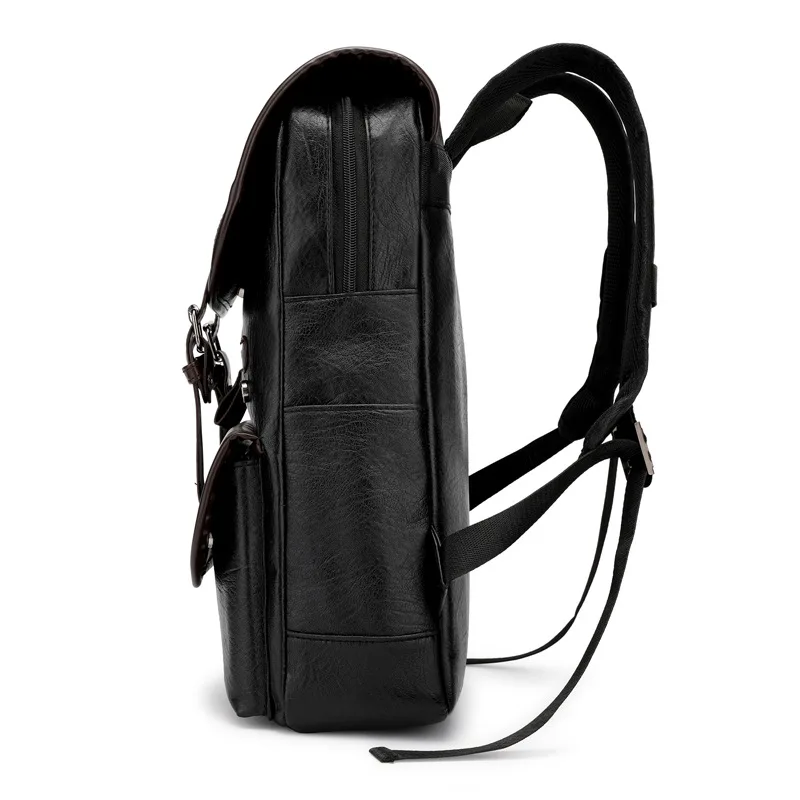
The aesthetic dimension of your leather backpack plays a crucial role in its multi-use functionality. A truly versatile bag must look appropriate across different environments, complementing rather than conflicting with your personal style and professional image.
Matching Design Aesthetics to Professional Environments
Different workplace cultures have different expectations for accessories. Consider these guidelines when selecting a style that works for your professional context:
Traditional Corporate Settings: Choose structured designs with clean lines, minimal external hardware, and refined leather finishes. Black, dark brown, and navy typically work best in conservative environments.
Creative Industries: More expressive designs with unique hardware, interesting textures, or vintage-inspired details can work well while still maintaining professionalism.
Flexible/Hybrid Workplaces: Look for a middle ground with classic shapes executed in slightly more casual leathers or with subtle distinctive details that transition well between formal and relaxed settings.
Classic vs. Contemporary Styling
Classic backpack designs typically feature symmetrical proportions, traditional hardware, and established silhouettes that have remained relevant for decades. These styles tend to have longer aesthetic lifespans and won’t look dated quickly.
Contemporary designs might incorporate asymmetrical elements, modern hardware finishes, or innovative closure systems. While these can make a stronger style statement, consider whether the design will still look current in 5-10 years, given the longevity of quality leather.
Color Selection Strategy
For maximum versatility, neutral colors provide the widest application across different settings:
Black: The most formal option, pairs easily with business attire and never looks out of place in professional settings. Shows less obvious wear but can display dust and lint more visibly.
Dark Brown: Nearly as versatile as black but with a warmer, slightly more casual appearance. Works exceptionally well across business casual and smart casual environments.
Tan/Cognac: More casual than darker options but still appropriate in most modern workplaces. Develops the most visible and attractive patina over time, showing the leather’s evolving character.
Navy: An excellent alternative to black that maintains formality while offering a distinctive appearance. Pairs particularly well with blue-toned business wardrobes.
For those interested in expanding their knowledge of appropriate styling, learning how to master styling men’s leather backpacks can help maximize the versatility of your investment.
Essential Care Tips for Lasting Quality
Proper maintenance ensures your leather backpack develops beautiful character rather than premature wear. Establishing a regular care routine extends the life of your investment and maintains its appearance across various environments.
Initial Treatment
New leather backpacks often benefit from preparation before regular use:
1. Gently wipe the surface with a slightly damp cloth to remove any manufacturing dust
2. Allow to fully dry at room temperature away from heat sources
3. Apply a thin layer of appropriate leather conditioner
4. Let the conditioner absorb for 24 hours before first use
5. Consider a light application of leather protector for water resistance
This initial treatment establishes a protective foundation and begins the conditioning cycle that maintains leather’s suppleness.
Regular Maintenance Schedule
Establish a consistent care routine based on your usage patterns:
* Light use (weekly): Condition every 4-6 months
* Regular use (daily): Condition every 2-3 months
* Heavy use or weather exposure: Condition every 1-2 months
Between conditioning treatments, implement these simple practices:
* Wipe the exterior with a soft cloth weekly to remove dust and pollutants
* Clean interior periodically by gently vacuuming or wiping with a lightly damp cloth
* Address spills or marks immediately rather than allowing them to set
Cleaning Techniques
Different leather types require specific cleaning approaches:
Full-Grain and Top-Grain Leather:
1. Remove surface dust with a soft brush or cloth
2. Clean with a damp cloth or specialized leather cleaner
3. Use minimal water and never saturate the leather
4. Allow to dry naturally away from direct heat
5. Follow cleaning with conditioner to replace lost moisture
Treated or Finished Leather:
1. Check manufacturer recommendations for specific products
2. Use cleaners designed for protected leathers
3. Test any product on an inconspicuous area first
Conditioning Methods
Proper conditioning maintains leather’s natural moisture and prevents cracking:
1. Select a quality leather conditioner appropriate for your specific leather type
2. Apply sparingly with a soft cloth using circular motions
3. Focus on stress points (handles, strap connections, corners)
4. Allow to absorb fully before buffing excess with a clean cloth
5. Let the backpack rest 12-24 hours before using
Storage Recommendations
Proper storage prevents deformation and damage during periods of non-use:
* Store upright or hanging rather than flattened or compressed
* Stuff with acid-free tissue paper to maintain shape
* Use the dust bag provided or a pillowcase to protect from dust
* Keep away from direct sunlight and heat sources
* Avoid plastic covers that prevent leather from breathing
* Store in moderate humidity (too dry causes cracking; too humid promotes mold)
Addressing Common Issues
Water Damage:
1. Blot excess moisture immediately (never rub)
2. Allow to dry naturally at room temperature
3. Once completely dry, assess any water spots or stiffness
4. Apply conditioner to restore suppleness
5. For stubborn water marks, consult a leather professional
Scratches and Scuffs:
1. For minor scratches, gently rub with a clean fingertip to warm the leather and redistribute oils
2. Apply a small amount of conditioner to the area
3. For deeper scratches, use a matching leather cream
4. Remember that some marks become part of the leather’s character and patina
Hardware Maintenance:
1. Clean metal hardware with a soft cloth
2. Address squeaky zippers with a zipper lubricant (never oil)
3. Tighten loose screws carefully
4. Protect metal components from extended moisture exposure
For comprehensive guidance on maintaining your investment piece during periods of non-use, explore detailed leather backpack storage techniques to preserve shape and prevent damage.
Comparative Analysis: Finding Your Perfect Match
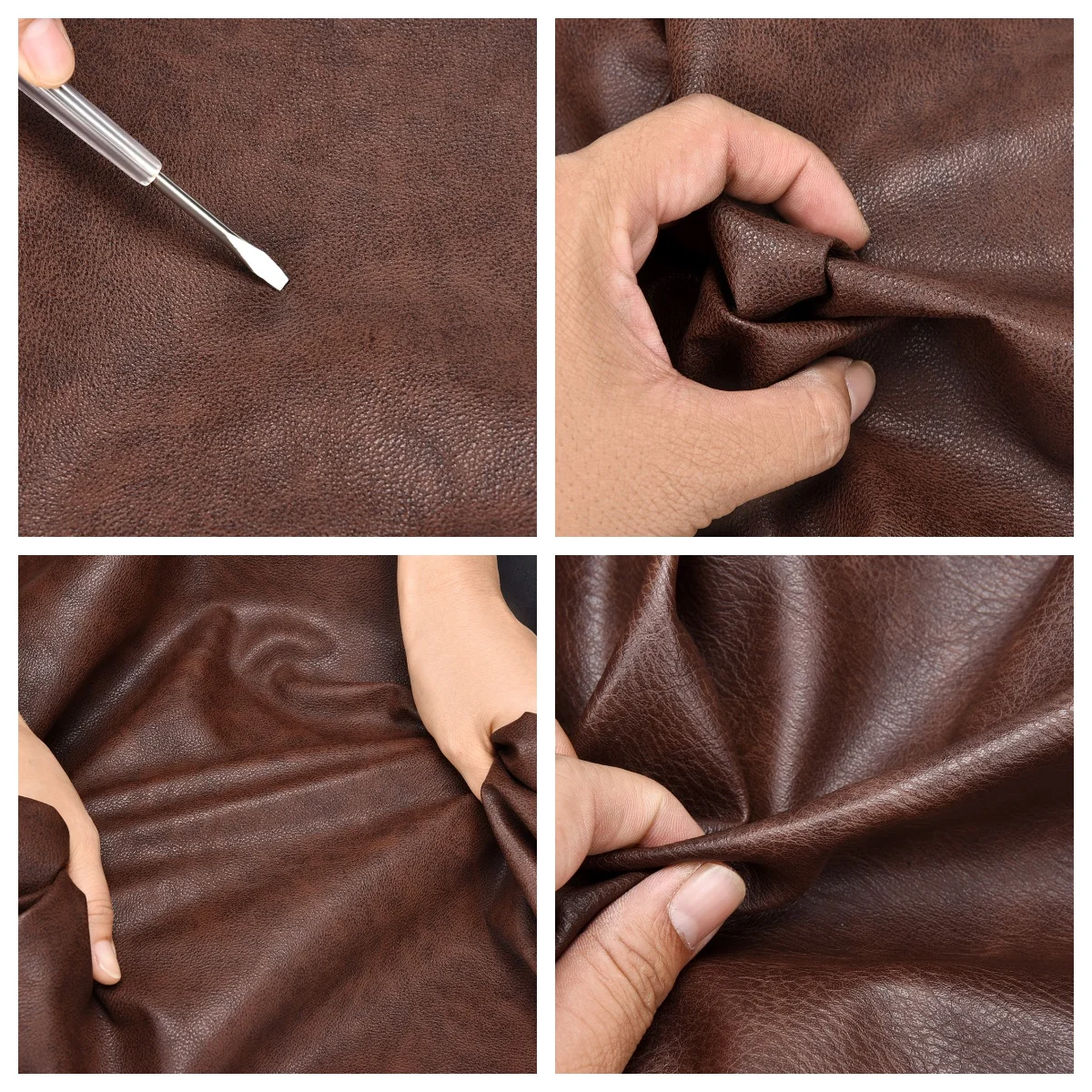
When evaluating different multi-use leather backpack options, a systematic comparison helps identify which features best align with your specific needs. Consider this comparative framework organized by key decision factors:
| Feature | Executive Style | Travel-Focused | Minimalist Design | Weekend/Casual |
|---|---|---|---|---|
| Ideal Leather | Full-grain, top-grain with smooth finish | Full-grain, oil-tanned | Full-grain with natural texture | Full-grain, Crazy Horse/pull-up |
| Capacity | 18-22 liters (1098-1342 cu in) | 24-30 liters (1464-1830 cu in) | 14-18 liters (853-1098 cu in) | 20-26 liters (1220-1586 cu in) |
| Laptop Size | Dedicated 15-16” compartment | Protected 15” with easy access | Sleeve for 13-15” devices | Padded 15” compartment |
| Carrying Options | Backpack, top handle | Backpack, side handle, luggage strap | Backpack, convertible briefcase | Backpack, top handle |
| Organization | Multiple dedicated compartments | Adaptable spaces, packing features | Minimal, thoughtful organization | Flexible main space with pockets |
| Price Range | $300-500 | $350-600 | $250-400 | $280-450 |
| Weight | 3.0-3.5 lbs (1.4-1.6 kg) | 3.5-4.5 lbs (1.6-2.0 kg) | 2.0-3.0 lbs (0.9-1.4 kg) | 3.0-4.0 lbs (1.4-1.8 kg) |
| Best For | Daily office use with occasional meetings | Frequent business travel | Minimalist daily carry | Versatile weekday to weekend |
Decision Framework
Consider your primary use case as the foundation of your decision:
Daily Office Commute: Prioritize professional appearance, laptop protection, and document organization. Weight is an important consideration for daily carrying.
Frequent Business Travel: Focus on TSA-friendly features, expandability, and durability across different environments. Comfort features become more critical for extended carrying periods.
Minimal Everyday Carry: Emphasize sleek design, lightweight construction, and essential organization without unnecessary bulk or compartments.
Versatile Lifestyle Use: Look for adaptable designs that balance professional appearance with relaxed styling elements, featuring flexible organization.
Value Considerations
The price-to-value relationship varies across different segments of the market:
$200-300 Range: Typically offers good leather quality (often top-grain) with solid construction but fewer specialized features or details. Best for those new to leather goods or with budget constraints.
$300-500 Range: Represents the sweet spot for many buyers, offering excellent leather quality, thoughtful design features, and construction techniques that ensure longevity.
$500+ Range: Provides premium materials (highest grade full-grain leather), exceptional craftsmanship with attention to small details, and often unique design elements or brand prestige. The incremental functional benefit may be smaller than the jump from budget to mid-range.
For those prioritizing travel functionality with leather’s premium aesthetic, exploring leather travel backpacks provides options specifically designed for life on the move while maintaining professional appearance.
Expert Tips for Maximizing Your Multi-Use Backpack
Once you’ve selected the perfect leather backpack, these expert strategies help maximize its versatility across different scenarios:
1. Master Modular Packing
Develop different packing configurations for your various needs:
– Daily Work: Focus on technology protection, document organization, and everyday essentials positioned for quick access
– Overnight Business: Utilize compression packing techniques for clothing, keeping business materials separate and accessible
– Weekend Travel: Maximize main compartment space by consolidating smaller items into pouches or organizers
Creating consistent locations for essential items across different scenarios reduces the mental effort of transitioning between uses and minimizes the chance of forgetting important items.
2. Transition Between Carrying Styles Effectively
For convertible designs:
– Practice quick transitions between carrying modes before you need them in real-world situations
– Adjust strap lengths and positions for your specific body dimensions in each configuration
– Store unused straps neatly to maintain a clean appearance when using alternative carrying methods
3. Optimize Weight Distribution
Strategic packing improves comfort and maintains your backpack’s appearance:
– Position heavier items closest to the back panel and centered vertically
– Distribute weight evenly between left and right sides
– Place frequently accessed items in external or quick-access pockets
– Use all available compression features to secure contents and prevent shifting
4. Adapt Seasonal Strategies
Modify your approach based on seasonal changes:
– Summer: Carry a thin packable layer for aggressive air conditioning; consider leather protection against increased sun exposure
– Winter: Adjust strap length to accommodate thicker clothing; allow leather to gradually acclimate to temperature changes
– Rainy Seasons: Apply appropriate leather protectant more frequently; carry a compact microfiber cloth to dry the exterior
5. Enhance with Complementary Accessories
Strategic accessories extend functionality without requiring a different bag:
– Tech organizers keep cables, chargers, and adapters neatly contained
– Slim packing cubes maximize space efficiency for clothing
– Leather card wallets provide quick access to frequently used cards
– Waterproof pouches protect valuable items during unexpected weather
For more detailed strategies on optimizing internal organization, explore techniques for mastering organization in leather bags to maximize efficiency and accessibility.
Frequently Asked Questions
How heavy are leather backpacks compared to synthetic materials?
Leather backpacks typically weigh 30-50% more than their synthetic counterparts of similar size. A medium-sized leather backpack often weighs 2.5-4 pounds (1.1-1.8 kg) empty, while similar nylon or polyester designs might weigh 1.5-2.5 pounds (0.7-1.1 kg). This additional weight results from leather’s natural density and the substantial hardware typically used in quality leather goods. However, this weight differential represents a trade-off for leather’s superior durability, professional appearance, and character development over time.
Can I use leather backpacks in rainy conditions?
Quality leather backpacks can handle light rain exposure, especially when properly treated with appropriate leather protectants. However, extended exposure to heavy rain can potentially damage untreated leather, causing water spots or stiffness when dried. Full-grain and oil-tanned leathers typically offer better natural water resistance than other varieties. For regular use in rainy climates, consider applying leather waterproofing products seasonally or selecting backpacks with built-in rain covers.
What’s the difference between full-grain and top-grain leather?
Full-grain leather preserves the hide’s entire top surface with its natural grain pattern intact, resulting in the strongest, most durable leather with distinctive character development over time. Top-grain leather undergoes light sanding to remove imperfections, creating a more uniform appearance at the cost of some durability and natural character. Full-grain typically develops a richer patina and offers superior longevity, while top-grain provides a more consistent appearance and slightly better value. Both represent quality options superior to genuine leather or bonded leather.
How long should a quality leather backpack last?
With proper care and maintenance, a high-quality full-grain leather backpack should last 15-20 years or more of regular use. Many premium leather goods become family heirlooms, remaining functional and developing character for decades. The most common failure points are typically hardware elements (zippers, clasps) rather than the leather itself, and these can often be repaired by a skilled leather worker. This exceptional longevity contributes significantly to the value proposition of investing in quality leather goods.
Are leather backpacks appropriate for business settings?
Well-designed leather backpacks are increasingly accepted in business environments, particularly styles featuring clean lines, professional hardware, and structured designs. Dark colors (black, dark brown, navy) typically present the most formal appearance. Many executive-focused designs incorporate briefcase elements like document organization and laptop protection while maintaining the practical carrying comfort of a backpack. For highly formal environments, consider convertible designs that can be carried as a briefcase when appropriate.
How do I know if a leather backpack will meet airline carry-on requirements?
Most medium-sized leather backpacks (19-25 liters/1159-1525 cubic inches) comply with standard airline carry-on dimensions, typically restricted to approximately 22 × 14 × 9 inches (56 × 36 × 23 cm). However, requirements vary between airlines and routes, particularly on smaller regional aircraft. When evaluating backpacks for travel, look for designs that maintain a consistent shape when packed and avoid those with excessive external pockets that expand unpredictably. For frequent travelers, backpacks specifically marketed as “travel-friendly” or “carry-on compliant” typically incorporate appropriate dimensions.
Can leather backpacks accommodate modern tech accessories?
Contemporary leather backpack designs have evolved to address modern technology needs, often featuring padded laptop compartments, tablet sleeves, cable management systems, and power bank pockets. Many incorporate RFID-protected sections for digital cards and passports. When evaluating tech compatibility, check not only the dimensions of dedicated tech compartments but also their positioning (ideally against the back panel) and access design (separate access can be valuable for security checkpoints).
The innovative features found in modular leather backpack designs provide particularly effective solutions for organizing and protecting modern technology within classic leather aesthetics.
Making the Investment: The True Value of a Quality Leather Backpack
When considering a multi-use leather backpack, it’s important to recognize that you’re making more than a purchase—you’re making an investment in a companion that will serve you faithfully through countless daily journeys and adventures.
The long-term value proposition becomes clear when calculating cost-per-use over time. A quality leather backpack priced at $350 that provides daily service for 10 years costs approximately 10 cents per day of use—less than most disposable items we consume without thought. Contrast this with synthetic alternatives that might need replacement every 1-2 years, and the financial advantage becomes evident despite the higher initial investment.
Beyond pure economics, there’s a meaningful sustainability aspect to choosing quality leather goods. In our era of fast fashion and disposable products, a backpack designed and constructed to last decades represents a conscious step away from the consumption cycle. The environmental impact of producing one quality item versus several replacements significantly favors the durable approach, particularly when the leather comes from responsible sources using natural tanning processes.
Perhaps most valuable is how a truly versatile backpack simplifies daily life. Rather than maintaining multiple specialized bags and transferring essentials between them, a well-designed multi-use backpack adapts to your changing needs. This simplification extends beyond convenience—it represents a philosophical approach to ownership focused on fewer, better things that provide greater satisfaction.
The intangible benefits of carrying quality accessories shouldn’t be underestimated either. There’s a quiet confidence that comes from knowing your tools are capable and reliable. A quality leather backpack communicates attention to detail and discernment without saying a word, creating positive impressions in both professional and personal contexts.
Most uniquely, leather products tell a story over time that no synthetic material can match. As your backpack ages, it develops a patina reflecting your journeys together—darkening at the handles from your touch, softening at the corners from use, and gradually molding to your specific carrying patterns. This evolution creates a deeply personal item that can’t be replicated or replaced, regardless of price.
In a world increasingly defined by digital experiences and temporary possessions, there remains something profoundly satisfying about investing in physical goods crafted with care and designed for permanence. A quality leather backpack stands as a tangible counterpoint to disposability—a daily reminder that some things are meant to last.
